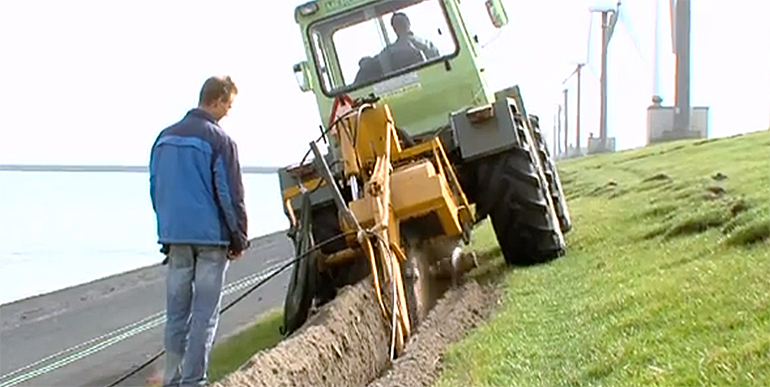Three sensor systems keep a close eye on weak spots in Groningen sea dike, the Netherlands
 Three newly developed real time monitoring systems have been installed in the Ommelander sea dike in the Northern Netherlands. The data from the three systems is collected in the Dike Data Service Centre where it is made available to the dike management of water board Noorderzijlvest.
Three newly developed real time monitoring systems have been installed in the Ommelander sea dike in the Northern Netherlands. The data from the three systems is collected in the Dike Data Service Centre where it is made available to the dike management of water board Noorderzijlvest.
A number of stretches of the dike are deemed unsafe in terms of macro stability and micro stability. Water board Noorderzijlvest intends to reinforce its sea dikes along the Wadden Sea in four years.
By closely monitoring the sea dikes, especially during extreme weather events, the water board will learn more about the weak spots, allowing it to take more effective reinforcement measures.
The real time dike monitoring systems have recently been developed as part of the 'field lab' IJkdijk research programme. It is for the first time that an existing stretch of dike is being monitored with three systems simultaneously.
Three monitoring systems
The Ommelander sea dike is monitored both remotely (remote sensing) and in situ (in the dike itself). This is achieved using three different measuring techniques:
- water tension meters and monitoring wells
- Dike Monitoring and Conditioning system (DMC)
- Intech Dike Security System (IDS)
These measurements are coupled to information about the underlying ground and surrounding area in order to get a good idea of what is happening in the dike.
An extensive ground research has been carried out in order to map out the layering of the dike effectively.
Raising water levels and pressure deviations
Sensors measure water tension in the dike, in order to show rising heights and pressure deviations. The water board then incorporates this data in design calculations. This measuring data allows more certainty in determining the parameters which form the basis for the dike improvement design. And so the design of the dike reinforcement measures can be made more effectively.
The effects of reinforcement measures can subsequently be monitored, which in turn provides know-how which can be applied in order to solve similar problems elsewhere in the Netherlands and further afield.
Overly high water tension
The Dike Monitoring and Conditioning system (DMC) comprises a horizontal filter pipe in the dike. A glass fibre sensor in the pipe measures the water tension and temperature. The system not only supplies interesting information for design calculations but also anticipates alarming values. An overly high water tension can indicate stability problems, while a deviating temperature can be a sign of a damaging water flow.
In both cases, the DMC system pumps water out of the dike in a controlled manner, via the filter pipe, thus improving the stability and strength of the dike.
Temperature deviations
The Intech Dike Security System (IDS) comprises a mobile camera with which infrared pictures can be taken. Unlike the water tension meters and the DMC system, the mobile camera can monitor a considerable length of dike over a relatively short period of time. Infrared images visualise superficial temperature deviations along an 8.5 kilometre stretch of dike. This allows early detection of wells or any other instability problems.
The images provide insight into the problem locations, thus helping Noorderzijlvest prioritise the approach to these locations. Moreover, the water board can quickly anticipate any resultant risks.
Dike Data Service Centre
The measuring data provided by the monitoring systems is collected in the Dijk Data Service Centrum(DDSC). Here, the data from all the monitoring systems is combined with existing information on the dike, such as the height, thickness of the earth layer and compilation of the underlying ground.
The Noorderzijlvest water board therefore has a central location at its disposal where all information is available and is easily accessible. The dike management board has live images of the dike and can request any necessary data.
Real-time picture of dike's strength
The Dike Data Service Centre (DDSC) is being built for Stichting IJkdijk by the consortium of Nelen & Schuurmans and Fugro GeoServices. The centre will link the monitoring system to models for prediction of the strength. This will provide a real-time picture of the dike's strength, for the purpose of crisis teams, for example. Water managers can also compare the situation in various dikes online, in order to learn from each others' experience.
The DDSC is built entirely of open source software and uses open standards (Aquo standard) and exchange formats. An important foundation has therefore been laid for a more sustainable development relationship between the public and corporate bodies involved.
Read also on this website:
- Deltares to supervise new all-in-one sensor experiment in full scale test embankment IJdijk (21 May 2012)
- New tests IJkdijk: dike breaches predictable with new sensor systems (13 September 2012)
More information
Dijk Data Service Centrum
Stichting IJkdijk
Groningen, the Netherlands
+31 50 521 44 66
www.ijkdijk.nl/en/ddsc
Impression of the development of new sensor systems as part of the IJkdijk research programme (Dutch spoken, English subtitles)



